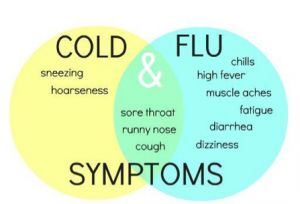During the chilly winter months it is not altogether uncommon to experience those unpleasant symptoms associated with the flu ie. sneezing, stuffy nose, sore throat etc. Now determining whether it’s a common cold or the dreaded flu is where the challenge lies. The 2 “sister illnesses” manifest in much the same way, thus making diagnosis somewhat tricky. And considering further similarities like the seasonal occurrence and incidence of the 2, it might be worthwhile to familiarise oneself with the detail in the differences.

Characteristics of the Common Cold
The common cold, medically known as a viral upper respiratory tract infection, can be caused by a multitude of viruses (over 200 different types). The Rhinovirus is most prevalent in early autumn, spring, and summer, causing anywhere from 10 to 40 percent of colds. Coronavirus is typically observed during the winter and early spring. Other viral agents like RSV and parainfluenza can potentially lead to severe infections, like bronchitis or pneumonia.
Typical cold symptoms include sneezing, blocked nose, mild pain, moderate cough, slight chest discomfort, and a sore throat.

Characteristics of the Flu?
The flu on the other hand, tends to have a quicker onset and more severe symptoms than the common cold. It is caused by influenza virus types A, B, and C. Types A and B cause large seasonal outbreaks while type C usually only causes mild respiratory symptoms. Influenza can become relatively problematic when it migrates deep into the lungs, causing more serious issues such as breathing difficulty, pneumonia, or bronchitis.
Symptoms often include sneezing, blocked nose, sore throat, headache, fever, fatigue, severe cough and pain in the chest and body.

Accurate Diagnosis
Timely and accurate diagnosis of patients with respiratory illness ensures the best chance of appropriate treatment.
Once influenza is suspected, samples from the upper respiratory tract should be collected and tested for the presence of the virus in an appropriate laboratory environment. There are various testing methods available that can aid in flu diagnosis, but nasopharyngeal specimens typically provide a higher yield than nasal or throat swabs.
It is recommended that samples are collected at the earliest possible convenience, following the onset of symptoms (three or four days is ideal), in order to optimise detection.

In the case of colds, more often than not they run their course before diagnosis can be determined. And for that reason, rhinovirus-detection laboratory tests are not routinely used; so diagnosis would be largely based upon observation of the physical symptoms present. It is advisable, however, to conduct tests on children under the age of 2, the elderly, and the immuno-compromised.

